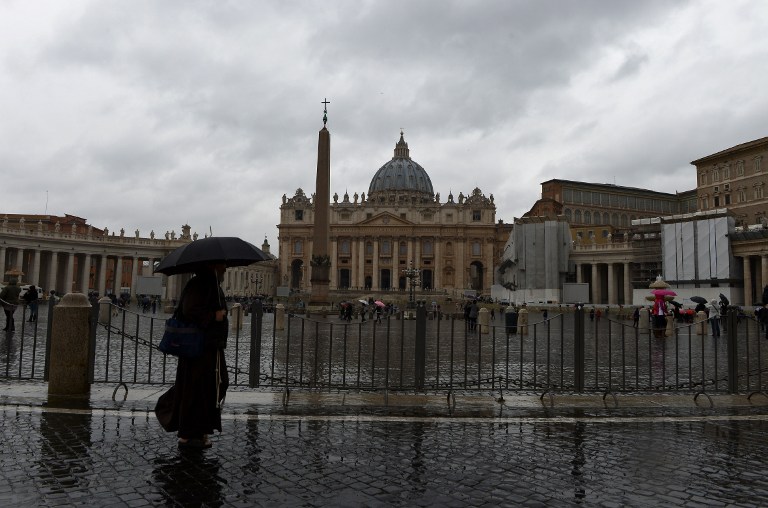SUMMARY
This is AI generated summarization, which may have errors. For context, always refer to the full article.

VATICAN CITY – Roman Catholic cardinals from around the world will assemble in the Vatican’s Sistine Chapel from Tuesday, March 12, for a conclave to elect a new pope in an unprecedented transition after Benedict XVI’s historic resignation.
The centuries-old ritual filled with rich imagery and tradition begins when all the cardinals swear a solemn oath of secrecy at 1545 GMT and hold a first vote to find a new leader for the 1.2 billion Catholics around the globe.
Beyond the Renaissance symbolism and rules that cut off the cardinals from any contact with the outside world during the conclave, the challenge will be to find a 266th pope able to deal with the many challenges assailing the Church.
The abrupt end to Benedict’s often troubled pontificate has brought into sharp relief the need for a new kind of leader able to face growing secularism in the West and rising Islamic radicalism in many parts of the world.
Cardinals have called for a more vigorous, pastoral figure who can also overhaul the intrigue-filled Roman Curia, the central government of the Church, and deal with the ongoing scandal over sexual abuse by pedophile priests and cover-ups.
The calls for transparency have intensified since last year when hundreds of confidential papal documents were leaked by Benedict’s butler Paolo Gabriele in a scandal known as “Vatileaks” that revealed infighting inside the Curia.
The tradition of priestly celibacy and the calls for an easing of the Catholic Church’s hardline stance against artificial contraception and same-sex unions will also be high on the next pope’s agenda.
The 115 “cardinal electors” – cardinals below the age limit of 80 – are unlikely to veer far from the conservative views of Benedict XVI and his predecessor John Paul II since they were all appointed by the two popes.
But Benedict’s revolutionary act of resignation – only the second pope to do so by choice in the Church’s 2,000-year history – has sent shock waves throughout the Catholic world, which could encourage the cardinals to make an equally unusual choice for a new leader of the Church.
‘No strong candidate’
The most oft-cited names are three cardinals in the same mould as Benedict: Angelo Scola, the archbishop of Milan, Odilo Scherer, the archbishop of Sao Paulo, and Marc Ouellet, prefect of the Congregation of Bishops.
But on the rumor mill in Rome are also the names of other Latin American cardinals as well as that of the 55-year-old Archbishop of Manila, Luis Antonio Tagle, who is popular but considered still too young for the office. (Watch Rappler’s video report below.)
Even seasoned Vatican observers admit that the field is still wide open.
“There is no strong candidate who has yet emerged,” said Marco Politi, an Italian expert on the Vatican and author of a biography of Benedict.
“In 2005, there was a strong candidate – Joseph Ratzinger,” he said.
There have been calls for the next pope to come from the southern hemisphere, where Catholicism is at its most vibrant and where the majority of the world’s Catholics live, but the odds in the conclave are weighted against this.
Of the 115 “Princes of the Church” taking part, 60 are from Europe and 14 from North America. Latin America has 19 cardinals, Africa 11, Asia 10 and Oceania one with George Pell, the archbishop of Sydney.
A two-thirds majority – 77 votes or more – is needed to elect a pope.
British Cardinal Keith O’Brien recused himself after Benedict’s resignation after admitting to sexual misconduct with priests in the 1980s.
This has encouraged calls from campaigners for other cardinals to be excluded for allegedly covering up abuses of children in their dioceses.
Benedict last month became the first pope to resign since the Middle Ages, saying he wanted to be “a simple pilgrim” on life’s last journey.
The 85-year-old stunned the world on February 11 when he admitted he had become too weak to keep up with a fast-changing modern world.
Tens of thousands of faithful flocked to a series of emotional farewells in which the pope said that his reign had seen “stormy waters.”
Now known by the newly-created title of “pope emeritus,” Benedict has stayed well out of the run-up to the conclave and will live in a former convent on a hilltop inside the Vatican walls.
Secretive election process
The election of his successor is a ceremony that dates back to the 13th century when cardinals were locked in the papal palace of Viterbo near Rome to force them to make a decision, which still took nearly 3 years.
The rules have been changed since then to speed up the election and Vatican spokesman Federico Lombardi has said it will take a few days at most.
The secrecy was imposed to try to prevent kings and queens from interfering with the papal election and it is enforced in modern-day conclaves with electronic jamming devices in the Sistine Chapel to block any communications.
The voting ballots will be burnt at around 1100 GMT following two rounds of voting in the morning and 1800 GMT after two rounds in the afternoon.
The smoke from a chimney above the Sistine Chapel is turned black to signal that there has been no decision, or white if the papal election has taken place and the cardinal has accepted his nomination.
The new pope retires to the “Room of Tears” next to the chapel before emerging onto a balcony over St Peter’s Square to cheering crowds and the cry of “Habemus Papam!” (“We Have a Pope!”). – Rappler.com
Add a comment
How does this make you feel?
There are no comments yet. Add your comment to start the conversation.